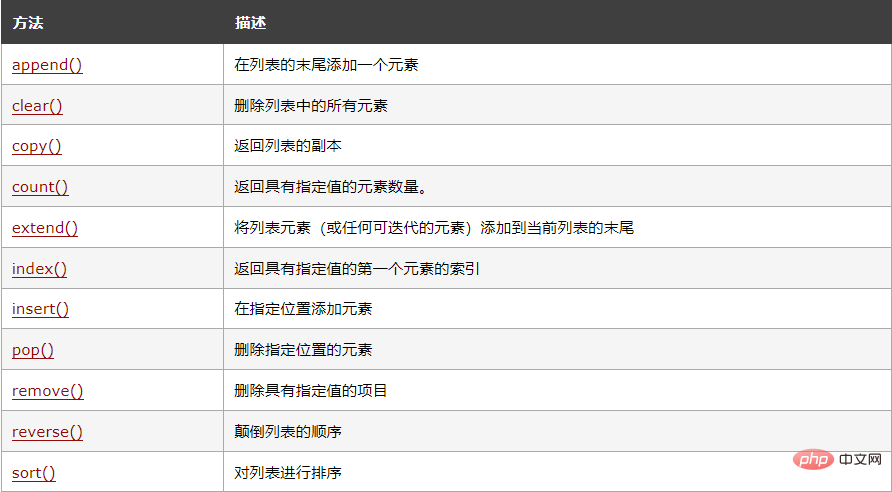
There are four collection data types in the Python programming language:
List (List) is an ordered and changeable gather. Duplicate members are allowed.
Tuple is an ordered and unchangeable collection. Duplicate members are allowed.
Set is an unordered and unindexed collection. There are no duplicate members.
A dictionary is an unordered, mutable and indexed collection. There are no duplicate members.
When choosing a collection type, it is useful to know the properties of that type.
Choosing the right type for a specific data set can mean preserving meaning, and it can mean improving efficiency or security.
A list is an ordered and changeable collection. In Python, lists are written using square brackets.
Instance
Create List:
thislist = ["apple", "banana", "cherry"] print(thislist)
Run Instance

You can access a list item by referencing the index number:
Example
Print the second item of the list:
thislist = ["apple", "banana", "cherry"] print(thislist[1])
Run the example

Negative index means starting from the end, -1 means the last item, -2 means the second to last item, and so on .
Example
Print the last item in the list:
thislist = ["apple", "banana", "cherry"] print(thislist[-1])
Run the example

Instance
Return the third, fourth, and fifth items:thislist = ["apple", "banana", "cherry", "orange", "kiwi", "melon", "mango"] print(thislist[2:5])

Example
This example Will return items from index -4 (included) to index -1 (excluded):thislist = ["apple", "banana", "cherry", "orange", "kiwi", "melon", "mango"] print(thislist[-4:-1])

Instance
Change the second item:thislist = ["apple", "banana", "cherry"] thislist[1] = "mango" print(thislist)

Example
One by one Print all items in the list:thislist = ["apple", "banana", "cherry"]
for x in thislist:
print(x)
Example
Check if "apple" exists in the list:thislist = ["apple", "banana", "cherry"]
if "apple" in thislist:
print("Yes, 'apple' is in the fruits list")
Example
Print the number of items in the list:thislist = ["apple", "banana", "cherry"] print(len(thislist))

Example
Use the append() method to append an item:thislist = ["apple", "banana", "cherry"]
thislist.append("orange")
print(thislist)
Instance
Insert item as second position:thislist = ["apple", "banana", "cherry"] thislist.insert(1, "orange") print(thislist)
 ##Delete items
##Delete items
The remove() method deletes the specified item: thislist = ["apple", "banana", "cherry"]
thislist.remove("banana")
print(thislist)

thislist = ["apple", "banana", "cherry"] thislist.pop() print(thislist)

实例
del 关键字删除指定的索引:
thislist = ["apple", "banana", "cherry"] del thislist[0] print(thislist)
运行实例

实例
del 关键字也能完整地删除列表:
thislist = ["apple", "banana", "cherry"] del thislist
运行实例

实例
clear() 方法清空列表:
thislist = ["apple", "banana", "cherry"] thislist.clear() print(thislist)
运行实例

您只能通过键入 list2 = list1 来复制列表,因为:list2 将只是对 list1 的引用,list1 中所做的更改也将自动在 list2 中进行。
有一些方法可以进行复制,一种方法是使用内置的 List 方法 copy()。
实例
使用 copy() 方法来复制列表:
thislist = ["apple", "banana", "cherry"] mylist = thislist.copy() print(mylist)
运行实例

制作副本的另一种方法是使用内建的方法 list()。
实例
使用 list() 方法复制列表:
thislist = ["apple", "banana", "cherry"] mylist = list(thislist) print(mylist)
运行实例

在 Python 中,有几种方法可以连接或串联两个或多个列表。
最简单的方法之一是使用 + 运算符。
实例
合并两个列表:
list1 = ["a", "b" , "c"] list2 = [1, 2, 3] list3 = list1 + list2 print(list3)
运行实例

连接两个列表的另一种方法是将 list2 中的所有项一个接一个地追加到 list1 中:
实例
把 list2 追加到 list1 中:
list1 = ["a", "b" , "c"]
list2 = [1, 2, 3]
for x in list2:
list1.append(x)
print(list1)运行实例

或者,您可以使用 extend() 方法,其目的是将一个列表中的元素添加到另一列表中:
实例
使用 extend() 方法将 list2 添加到 list1 的末尾:
list1 = ["a", "b" , "c"] list2 = [1, 2, 3] list1.extend(list2) print(list1)
运行实例

list() 构造函数
也可以使用 list() 构造函数创建一个新列表。
实例
使用 list() 构造函数创建列表:
thislist = list(("apple", "banana", "cherry")) # 请注意双括号
print(thislist)运行实例

Python 有一组可以在列表上使用的内建方法。

The above is the detailed content of What are the application methods of Python lists?. For more information, please follow other related articles on the PHP Chinese website!




